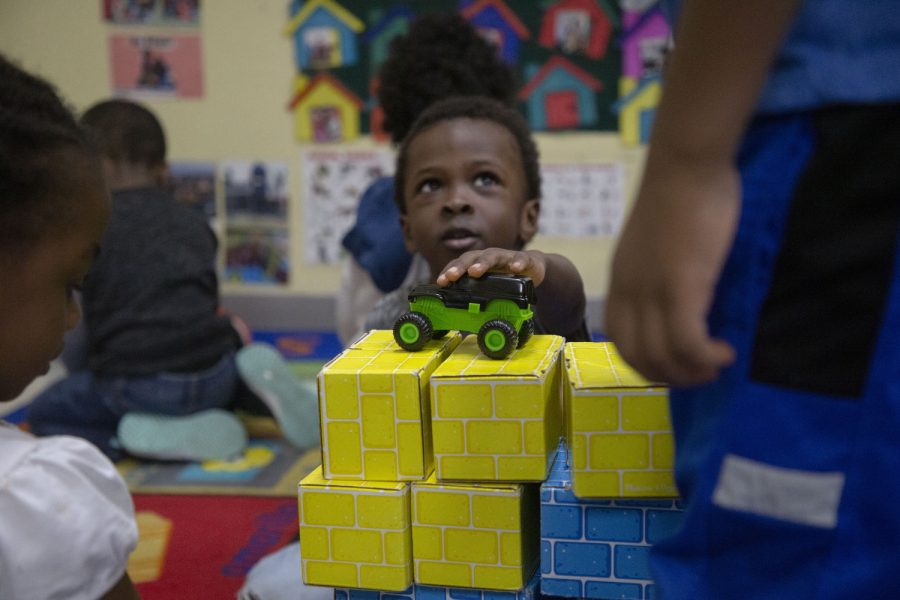UI assistant professor leads lab with Neighborhood Centers of Johnson County, analyzes speech development of bilingual preschoolers
The professor, Philip Combiths, started the project last year and initially began it as part of a class until receiving feedback from the Neighborhood Center and turning it into a research project.
A student from teacher Jihan Adam’s classroom plays with a green car at the Pheasant Ridge Neighborhood Center in Iowa City on Tuesday, Feb. 28, 2022.
February 28, 2023
A University of Iowa professor is collaborating with the Neighborhood Centers of Johnson County to track bilingual children’s speech development.
Philip Combiths, UI Department of Communication Sciences and Disorders assistant professor, is piloting the new research project with children who attend educational programs at the Broadway, Pheasant Ridge, and Breckenridge neighborhood centers. The research project is being conducted through the Clinical Linguistics and Disparities Lab, where Combiths serves as director.
The Neighborhood Centers of Johnson County is an organization focused on offering before and after school programs for children in areas throughout the county.
The pilot program tracks and analyzes the preschoolers — who speak Arabic, French, Spanish, Lingala, and Swahili — at the centers and how their English as a second language develops.
The current program started when Combiths arrived in Iowa in 2021 as an assistant professor and started a collaboration with the centers through one of his classes, he said.
“We had a class for our graduate students who were studying to become speech language pathologists,” Combiths said. “Our students would go into the centers and work with the teachers in the classroom to create an individualized sort of support plan for one of the kids in their classroom for whom they had some language concerns.”
While graduate students gained experience, and the neighborhood centers enjoyed having UI students, it put a strain on the K-12 teachers to swap out graduate students each semester and re-teach them school protocols, he said.
“So, the thought was, let’s address some of the questions and problems like challenges you’re facing here through a research project, and what’s nice about that is it’s couched in my lab and a research project is continual,” Combiths said.
The research project, Combiths said, revolves around language sampling of the children in addition to information gathered from parents at home to track language development.
Researchers conduct language sampling by recording a child speaking and transcribing their words into code. That code is then analyzed by a computer to see what words are used correctly compared to errors.
Jana Garrelts, Neighborhood Centers of Johnson County director of child care and learning programs, said there are over 100 kids at the centers each day, and 92 percent of the families speak another language at home.
Through an event in the fall, Garrelts said the centers equipped families with books written in their native language and encouraged them to continue speaking that language with their children at home.
“Parents really found that to be a helpful thing because I think they struggle with that a little bit — whether to speak in English and improve their children’s English or to speak in their home language — and it was almost like giving them permission,” Garrelts said.
Garrelts said the parents are interested in continuing the study to see where their children’s language development skills are and how their English language skills can develop.
“I’d be anxious to see what we get with the research and the data with that,” Garrelts said.
Emily Hartman, a fourth-year undergraduate student studying communications sciences and disorders, is in charge of designing the lab’s aims, questions, and goals in addition to teaching other members how to use the data program, Systematic Analysis of Language Transcripts, for the study.
“There are all these rules for how we would code it. And then the computer would read those codes and tell us all this information about it, and so I’ve trained myself in that and then generated conventions on how to train other people in that,” she said.
RELATED: First new hire of UI Transformational Faculty Hiring Program to start August 2023
The computer’s analysis can help identify struggle areas for children, Hartman said.
“Then, when you work with the child, if there are still struggles that the child has, it could be indicative that the child needs referral for further help from a professional,” she said.
The lab also implements a multi-tiered system support model in the English education classrooms in the centers, she said.
Combiths said the support model assists with questions that arise in a bilingual educational environment.
For example, a student in their first exposure to English may be exposed for four months and still not speak at the level expected. It can be difficult then to determine whether it’s an issue of speech or an issue of dual language learning, he said.
In these scenarios, there is often too much information gathered about their English language skills and not enough about their native language skills, which can lead to inaccurate conclusions about language learning difficulties, Combiths said.
“With this tiered process, you don’t have to make that clinical decision immediately all the time before helping them,” he said.
The tiered process also allows for more undergraduate participation, Combiths said.



